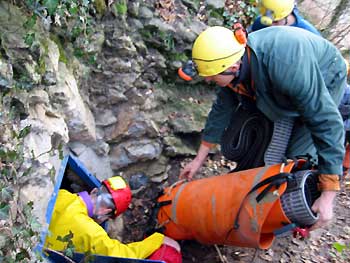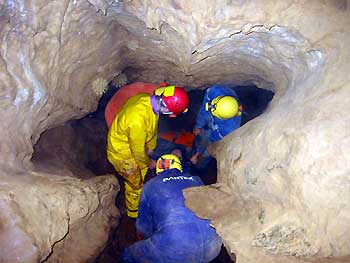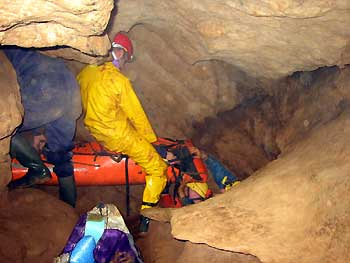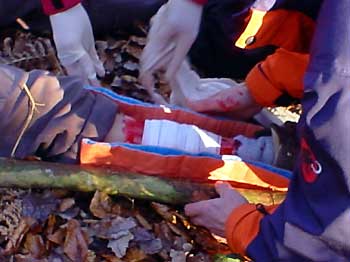Wilderness First Responder
From november 26th till december 4th 2003 Outward Bound Belgium organized a WFR-course for the 8th time in 8 years. The course was given by two instructors of the Wilderness Medical Associates , an american organization that presents the reference for wilderness emergency medical training worldwide. It was founded in 1978 by Peter Goth in order to create a medical screening for Outward Bound USA and has become something really big nowadays. What is wilderness medecine? Apart from the normal subjects treated in a normal first aid course, WMA-courses address three specific problems : extended patient management, extreme environments and limited equipment. Therefore improvisation is an essential skill in the wilderness setting.
 Eleven people arrived that morning at 0900 am at the Outward Bound coursehouse in Lustin(Belgium). It was a nice group consisting of some Dutch people, some Belgians, a guy from Slovakia, a Brit and an Italian Cypriot. Tom and Georgia, the two instructors, were waiting for us to introduce us to the magical miracles of the medical world and the complications brought by the wilderness context.
Eleven people arrived that morning at 0900 am at the Outward Bound coursehouse in Lustin(Belgium). It was a nice group consisting of some Dutch people, some Belgians, a guy from Slovakia, a Brit and an Italian Cypriot. Tom and Georgia, the two instructors, were waiting for us to introduce us to the magical miracles of the medical world and the complications brought by the wilderness context.
After an hour of administration the course really started with some theory about the legal aspects of first aid (e.g. the good samaritan law). Then we switched to CPR, the three major body systems and how to asses a patient. Therefore we used the Patient Assessment System (PAS) which I will explain more clearly later on.
From the next day on, everything seemed to come together in one gigantic stream of important stuff. We talked and learned about: asthma, anaphylaxis, respiratory distress, heart attacks, ischemia, diabetes, acute mountain sickness, burns, edema, femur fractures, dislocations, toxines, emergency childbirth, frostbite, droxning,... The theory was expanded but the practice was even more. PAS-drills, simulations and practical courses about epiinjections, backboards, splints and so on made it certain we learned to use everything we knew. Thus we had nine hours course a day and at least two hours of homework cause we really had to study for an exam that was waiting for us at the end of the course and 80% was the minimum to pass.

The most important of the whole course turned out to be the possibility to think in a logical way about every aspect of the patients situation you encountered. Therefore the PAS is a scheme that helps you to asses the patient in a safe, complete and correct way. You start with a safety analysis of the situation, decide what kind of injuries are possible and who's needed where. That part is called the Scene Size-Up. Than you can continue with an Initial Assessment where you control and adjust the mayor systems. Once you checked those, you can start with the less important injuries, a complete physical exam and the history of the patient and the event in the Focused History & Physical Exam. It's also important to write down and report in an organized way so that everyone believes you and your competency. The SOAP-notes are very helpfull to remember everything and to report it briefly and correct. SOAP stands for Subjective, Objective, Assessment and Plan.

The best part of all were the simulations. The first one was in the garden to get used to the idea What you see is what you get! If the instructors wanted us to treat a wound with spurting blood they would make it spurt. Once introduced to the concept we moved to the forest twice and a speleology-rescue was arranged as final challenge. The problems we encountered were very diverse. A broken cable on a ropes-section brought us severe concussions and leg fractures to treat, an epileptic climbing partner made his companion to get a shoulder dislocation and the girlfriend that ran away for help slipped and fell on a branch sticking out of the ground and now through her belly, three guys camping in the woods and smoking cigarettes above their stove were surprised by a thunderstorm and ended up with burns in the face, an apnea and broken eardrums (so funny) and the cave... yeah, that one made us sweat during the evacuation. I wonder why all those cavers have to injure their spine.

As you can read the course was a very intense and profound experience. On different aspects it gives an extra dimension to the normal first aid courses. The 6 wilderness protocols (Epinephrine for asthma and anaphylaxis, the repositioning of indirect dislocaties from shoulder, patella and digits, start and cessation of CPR, the clearing of the spine and the removal of impaled objects) are special skills you learn to use once you find yourself faced to those problems in a wilderness context. You're allowed to use them under specific conditions cause otherwise you bring other people in danger, make things worse, or evacuation would be impossible. You also learn to improvise a lot with all the materials you find, to make splints or litters and to improvise with all the things you learned. Sometimes you will have to make a risk-benefit choice.

It was a very interesting and pleasant experience thanks to the whole group.
Last word: We learned also a very different kind of language, namely one consisting of nothing but acronyms. PAS and Soap are two examples. AMFYOYO is a better one: Adios, motherfucker, you're on your own!
 I thank Tom en Georgia for the enthousiastic style they used to teach us this course and the whole group (Wim, Wim, Jo, Ine, Tom, Adriaan, Kevin, Mauro, Ori en Adinda) for the pleasant cooperation and the nice evening-hours. Sponsors are there to be thanked for: Kariboe, Rongen Consult and Outward Bound Belgium
I thank Tom en Georgia for the enthousiastic style they used to teach us this course and the whole group (Wim, Wim, Jo, Ine, Tom, Adriaan, Kevin, Mauro, Ori en Adinda) for the pleasant cooperation and the nice evening-hours. Sponsors are there to be thanked for: Kariboe, Rongen Consult and Outward Bound Belgium
Tijl
www.wildmed.com and www.outwardbound.be
You must be logged in to leave a comment
Log in
Register
Articles archive
News
Competition 7th in Kranj, Anak Verhoeven ends up 4th of the World Cup 2014
Last weekend, it is with a 7th place in Kranj that Anak Verhoeven finishes her first adults international season. Being very regular, the Belgian finishes like she started. With a place in the final. Anak got a 4th place in the general ranking.
Competition Loic Timmermans in silver at the Youth World Championships in Nouméa
Loic Timmermans ends in a perfect way his youth career. He has been on so many podium since he is a young kid and got this morning his last medal. During the Youth World Championship that took place in Nouméa, the Belgian ended in silver in Junior.


